
Elevation Gain: 3800'
10 miles RT
Left car: 7:30 am
Summit: 3:00 pm
Back at car: 6:45 pm
11.25 hours car to car
GPS route and topo provided by John Banes. The GPS has us going 11.5 miles and 4332' of elevation gain.
Planned a climb for Observation Rock mid week to avoid the crowds and was joined by Adam, Rich and John. Adam, John and I drove down from Seattle and met Rich at the Mowich Lake Trail Head. We geared up and were off.
We were going to use the Knapsack Pass approach to the climb as I felt it may be faster, or at least shorter. It took a bit of finding near the ranger's cabin at Mowich Lake and then we were heading up the trail. It took us an hour to reach Knapsack Pass (where we took a short break) on a pretty good trail which continued down the other side for a bit. Around 6000', the trail disappeared into a boulder field. There were a few cairns and then nothing. We picked our way through the boulder field which was somewhat loose and arrived at a gully on the other side. We watched a herd of goats scramble up the hillside before we were able to skirt the top of the gully on a snowfield where we picked up a faint trail and continued down to the Wonderland Trail.
The hike down to the intersection of the Wonderland Trail took longer than expected. Once there, we turned left and went about a 1/4 mile up hill (steps mostly) to the turn off for Observation Rock. We got on the climber's trail and headed up. This trail too is longer than it appears, and we spent a good deal of time getting closer to Observation Rock. Once closer to our destination the trail peters out a bit and we had to pick our way through a few little bumps on the ridge to where we could leave the moraine and head to the base of the north face.
We stopped there to gear up as rockfall is always hazardous this time of year at the base. We geared up, and scrambled the last bit of loose rock to the base where we got pelted with small rocks falling.
Adam and John quickly started out on their respective leads while Rich and I dodged golf ball sized rocks at the base. Soon we were simul climbing and getting out of the bulk of rockfall danger. (Although it did not feel soon enough.) The climbing was generally lower angle and easy at first, and Rich and I did join our respective partners at the first belay.
I led out on the next pitch going up through some solid ice with running water on top. Then conditions changed to a hollow snice on top of who knows what. I ran up a section of this between two muddy sections flanking it and was able to place a screw at the top. I continued a bit further where there was a nice stance and decided to set a belay. (I thought about continuing, but the stance was too nice to pass up as a belay.) Rich had made it a bit farther than me over to my left, but his stance looked significantly less comfortable than mine. And I remember from last time I climbed Observation Rock, that I got tired at bad belay stances.
I started to bring Adam up right after a softball sized rock whizzed by within six feet of him. He made his way up to me where he complained that his calves were toast, but that didn't stop him from racking up to lead off on the final pitch. I instructed him to use the water grooves as good rests and to try to resist front pointing to save his calves.
Adam headed out trending rightward up the grooves until it was feasible for him to head straight up. It was around this point that we realized he wouldn't hit flat snow/ice with the amount of rope left. He was fortunate to get to significantly less steep terrain with a decent ledge to set up a belay. I headed up quickly as my heels were hurting from my boots and I was a bit dehydrated and wanted to drink and eat at the top. Once passed Adam, he tore down the belay and we headed closer to the rock wall in hopes of getting in the shade.
Due to the moat and the crumbling rock wall, we had to stay on the snow to remove our gear and eat lunch. Fortunately the partly cloudy part of the day was starting and we were occasionally gifted with clouds blocking the sun. We sat down and eat and drank for at least a half hour. I took off my boots and taped my ankles even though I am pretty sure I was not getting blisters. However, I had to do something as I was experiencing lots of discomfort. Adam took a brief nap. Then we packed up to head to the summit.
The hike to the summit was a little rough. Typical two steps up and one step back on loose pumice. At least the rock was small and light and you are less concerned about injury from it. Just below the summit we dropped our packs before the last bit. What a relief. We all agreed that not having a pack made uphill travel easier. (Thank you team obvious.) We lounged at the summit a bit before starting back down.
We picked our way around the summit to the descent plunge stepping into loose pumice and even skiing it a bit. We made a brief stop to filter some water. Then we made our way back down to another section of the Flett Glacier between Echo and Observation Rocks and started walking down it. It soon turned to ice and we put our crampons on for a speedier direct descent down the glacier. Around a rock outcropping we continued down the glacier until we could move left toward a snowfield and regain the rock. We continued with our crampons on through a loose rock band and then down another snowfield before taking our crampons off near a well developed bivy site.
We regained the trail and started our long trail walk back to Knapsack Pass. Once again the trail took longer than it seemed. (Perhaps because we could see the pass the whole time?) We returned to the intersection with the Wonderland Trail and proceeded to get on the trail to Knapsack Pass. Now on the trail we had less navigational issues as it was fairly easy to stay on trail. Although due to the lengthy feel of the hike, we had thought we were off route at one point, only to be confirmed on route by John's GPS. We continued until we hit the boulderfield where we initially took a higher crossing and moved through it a bit quicker. Nearing the trail on the other side of the boulders, we dropped lower to a cairn only to have to climb back up to the trail. Back on the trail we dispatched that last of our uphill hiking to take a brief break at the pass before dropping the 1200' down to Mowich Lake.
Overall this was a fun trip with a friend and some new people. The conditions of the climb were much worse than when I had previously climbed it in 2007. This time around the ice was dirtier, and there was more rockfall. (And we climbing in late September in '07.) This is probably due to the extremely warm summer we have been having. Another thing too was that the face seemed to be mostly lit. I remember having no sun on the face for the climb and being quite cold last time. This time I prepared for it, but the sun raced up the slope with us leaving me somewhat dehydrated after the technical portion. (I drank five liters of water throughout the day.) Temps were high and this led to a general discomfort on my part as I was expecting things to be a touch cooler above 7000' and in the shade.
I have to say while I don't know if the Knapsack Pass approach was any quicker, it was a more interesting way to go. The 3+ miles of trail to get to Spray Park are not boring, but are tedious on the return and don't provide much along the way of views on the way in. The alternate approach kept our interest and gave us good views of Mist Park and some light scrambling as well. Although it may not be specific to this approach, the goat herd(s) in the area were actually afraid of people which I guess means they are not acclimated and expect food etc. from us. This is a totally different experience than Washington Pass or Enchantments goats. Also, I presume if you wanted to, you could also summit Fay Peak on the way out if you had the energy.
Speaking of scrambling peaks, my original intent was to scramble Echo Rock after the Observation Rock climb. However, we were a little late, and my feet were acting up. Adam was also in the fourth day of climbing out of the last five and was pretty knackered. Upon getting a closer look at Echo and the route up it, I don't know if I'd ever scramble it as the rock just seems horribly loose and the terrain steep enough to incur death with a mishap. John made the comment that it was a giant cairn.
Another issue is what was happening with my boots. I had a hot spot on the way up to Knapsack Pass in the morning which I addressed, but it continued. I then got a hot spot on the other foot as well. I attempted different lacings and by the top of the ice climbing I was practically in pain. Surprisingly I had no blister, but soggy feet. I bandaged and taped them, but they still gave me discomfort on the way down. This is the first time I had experienced problems with this particular pair of boots. I thought it may be due to walking a long distance is a stiff boot. And I am not unwilling to rule out walking in warm temps in an insulated boot as a contributing factor. It could be that my feet haven't truly recovered from the Forbidden epic, and wearing boots is going to be uncomfortable for me for a while.
My pics are here.


















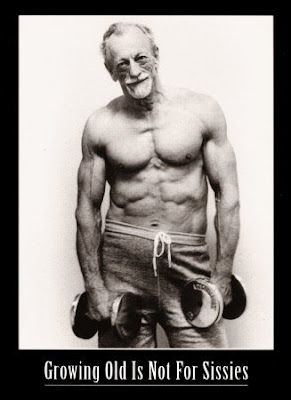






 The golden glow of the sunset over the marsh. My last night at Assateague.
The golden glow of the sunset over the marsh. My last night at Assateague. Not as colorful as the morning's sunrise had been, but quite lovely. Indeed.
Not as colorful as the morning's sunrise had been, but quite lovely. Indeed.




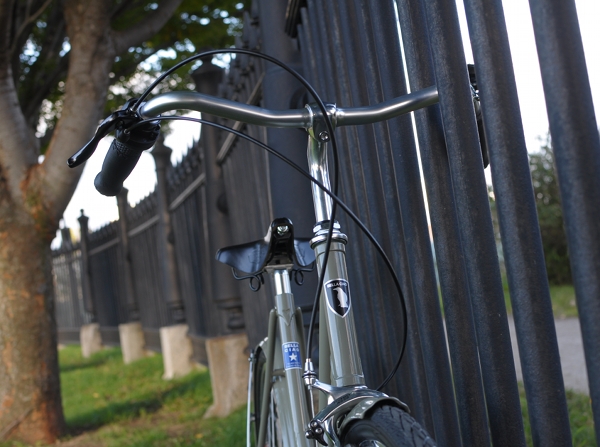 A couple of weeks ago I received aBella Ciaobicycle as part of a work-related trade. I have never been compensated for anything in bicycle before, but I think I could get used to this if absolutely forced to (at least for the benefit of providing test ride reports for my readers, right?). The bike was assembled with my preferences in mind, and I was invited to offer an honest critique.
A couple of weeks ago I received aBella Ciaobicycle as part of a work-related trade. I have never been compensated for anything in bicycle before, but I think I could get used to this if absolutely forced to (at least for the benefit of providing test ride reports for my readers, right?). The bike was assembled with my preferences in mind, and I was invited to offer an honest critique.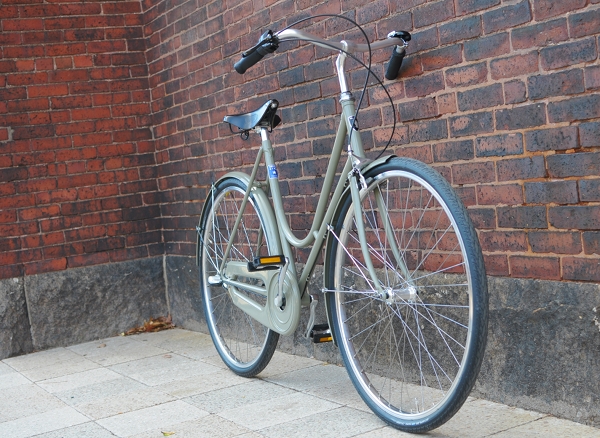 The bicycle is aBella Ciao"Corvo Citta Donna". The model name translates into something like "urban raven" anddonnaindicates that it is the lady's version. The colour (chosen by me) is "verde arsenale" - a pastel army green. Half a dozen other colours are available as well. The "Corvo Citta" models can be ordered as single speeds, 3-speeds, or 7/8-speeds, with or without coaster brake. I asked for a 3-speed coasterbrake version. The accessories are either honey or black, depending on the frame colour, and mine came with the black accessories package.
The bicycle is aBella Ciao"Corvo Citta Donna". The model name translates into something like "urban raven" anddonnaindicates that it is the lady's version. The colour (chosen by me) is "verde arsenale" - a pastel army green. Half a dozen other colours are available as well. The "Corvo Citta" models can be ordered as single speeds, 3-speeds, or 7/8-speeds, with or without coaster brake. I asked for a 3-speed coasterbrake version. The accessories are either honey or black, depending on the frame colour, and mine came with the black accessories package.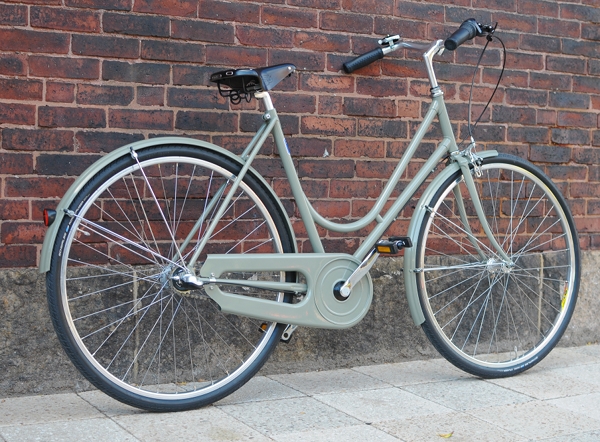 Bella Ciao frames are individually hand-made (brazed and lugged) by a small family-owned manufacturer in Northern Italy that has been building frames for generations. The standard models are cro-moly steel, though there are also limited editions made of Columbus tubing.Standard features on the Corvo Citta Donna include the classic Italian frame construction, 700C wheels with alloy rims, body-coloured fenders, an enclosed chaincase with a rear opening, leather saddle and grips,rear reflector,and a brass bell.
Bella Ciao frames are individually hand-made (brazed and lugged) by a small family-owned manufacturer in Northern Italy that has been building frames for generations. The standard models are cro-moly steel, though there are also limited editions made of Columbus tubing.Standard features on the Corvo Citta Donna include the classic Italian frame construction, 700C wheels with alloy rims, body-coloured fenders, an enclosed chaincase with a rear opening, leather saddle and grips,rear reflector,and a brass bell.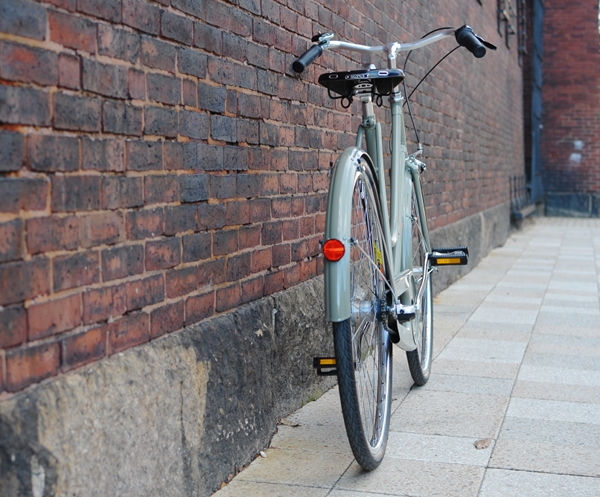 The frame is made in size 54cm (21.5") only, measured the "standard" way. This is an important point, especially if you are trying to compare the Bella Ciao to the Abici,whose sizing is measured differently. I would say that the Bella Ciao frame isslightly larger than the bigger of the two Abici frames.
The frame is made in size 54cm (21.5") only, measured the "standard" way. This is an important point, especially if you are trying to compare the Bella Ciao to the Abici,whose sizing is measured differently. I would say that the Bella Ciao frame isslightly larger than the bigger of the two Abici frames.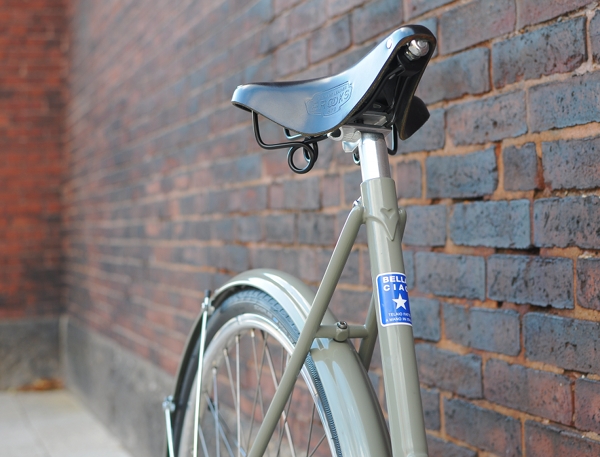 With its hardy tubing, modest lugwork, and thick powdercoating, the "Corvo Citta" is attractive, but decidedly utilitarian.
With its hardy tubing, modest lugwork, and thick powdercoating, the "Corvo Citta" is attractive, but decidedly utilitarian.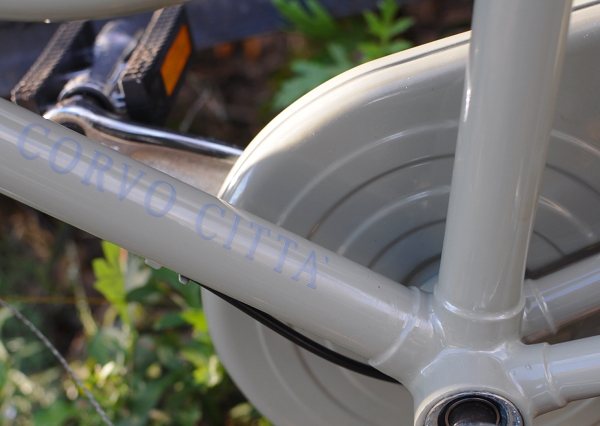 It is not a delicate bicycle by any means; the frame feels as if it can take anything that life has to offfer.
It is not a delicate bicycle by any means; the frame feels as if it can take anything that life has to offfer.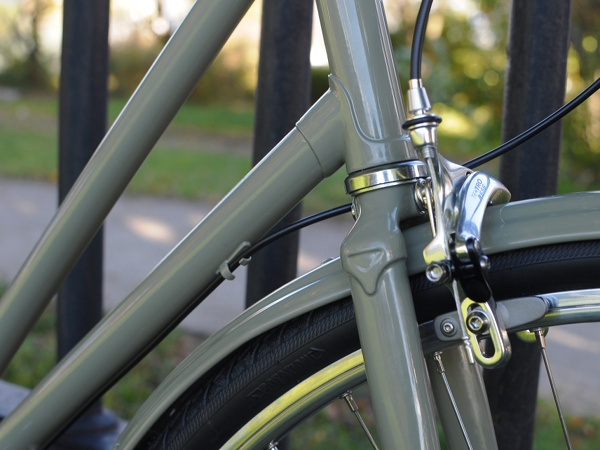 The lugged fork crown warms my heart; very nicely done. And look at the body-coloured cable guide braze-ons.
The lugged fork crown warms my heart; very nicely done. And look at the body-coloured cable guide braze-ons.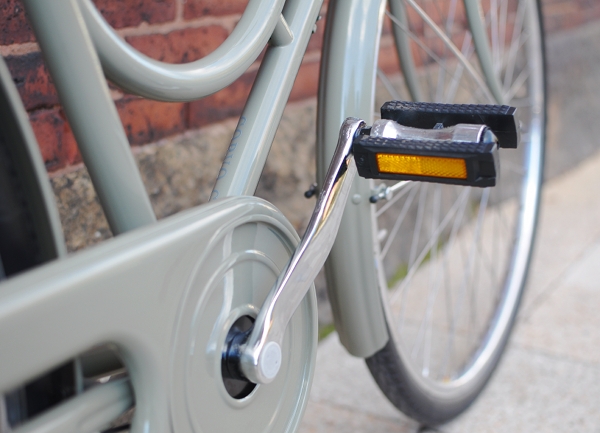 The only part of the frame that is not lugged, is the connector between the curved top tube and downtube. But if I have to choose between this and the fork crown, the latter is infinitely more important to me. (The connector on my Pashley was not lugged either.)
The only part of the frame that is not lugged, is the connector between the curved top tube and downtube. But if I have to choose between this and the fork crown, the latter is infinitely more important to me. (The connector on my Pashley was not lugged either.)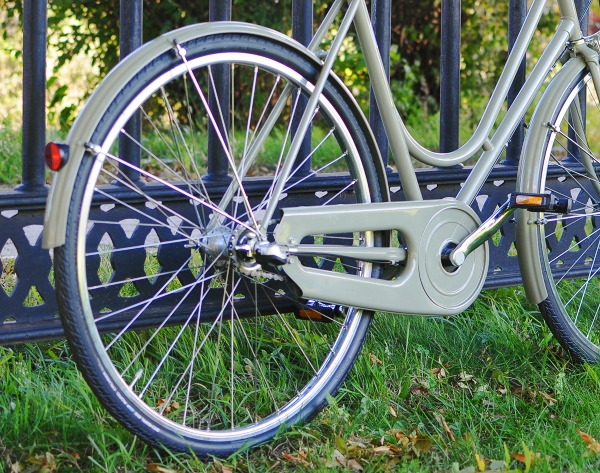 I like the elegant chaincase, and the interesting thing, is that despite being steel it is absolutely silent.
I like the elegant chaincase, and the interesting thing, is that despite being steel it is absolutely silent.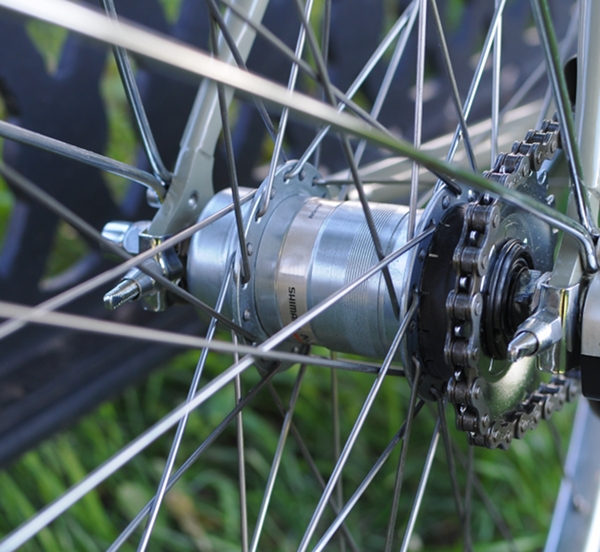 The Bella Ciao has straight fork ends, which I prefer on an internally geared hub bicycle. There are also chain tensioners installed - a detail the Co-Habitatant found especially exciting.
The Bella Ciao has straight fork ends, which I prefer on an internally geared hub bicycle. There are also chain tensioners installed - a detail the Co-Habitatant found especially exciting.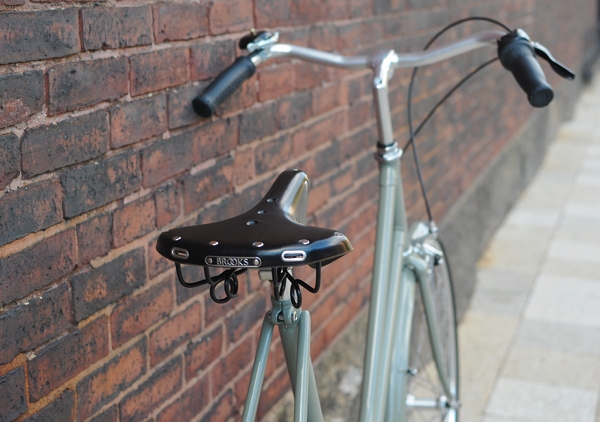 The bicycle arrived to me with a Brooks B17S saddle, but I immediately replaced it with a B72. I am not sure why both Bella Ciao and Abici use B17 saddles on their city bikes, but I think they need to rethink this choice - it is not an appropriate model for an upright ride, especially for women. The B72, on the other hand, feels absolutely at home here.
The bicycle arrived to me with a Brooks B17S saddle, but I immediately replaced it with a B72. I am not sure why both Bella Ciao and Abici use B17 saddles on their city bikes, but I think they need to rethink this choice - it is not an appropriate model for an upright ride, especially for women. The B72, on the other hand, feels absolutely at home here. 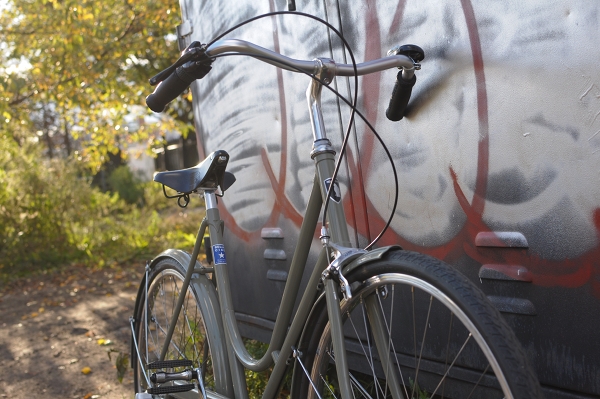 The minimal insignia on the Bella Ciao include a small headbadge on the head tube featuring the black raven logo, the "Corvo Citta" model name inscription near the bottom bracket, and a "fatto a mano in Italia" sticker on the seat tube.
The minimal insignia on the Bella Ciao include a small headbadge on the head tube featuring the black raven logo, the "Corvo Citta" model name inscription near the bottom bracket, and a "fatto a mano in Italia" sticker on the seat tube.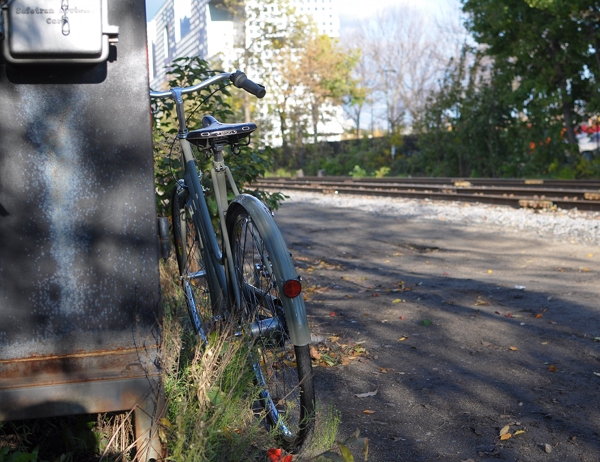 Moving on to ride quality... The most notable sensation I got from the Bella Ciao, was that it did not feel like a new bicycle. It felt very familiar, like an old bike that I have always owned.Lovers of classic bicycles complain that "there is no such thing anymore as a simple, well-made, lugged steel 3-speed bike". Well, I think the Bella Ciao isexactlythat. It is easy. It is comfortable. It is uncomplicated. It is not as laid back as a Dutch bike, but definitely not too sporty either (more relaxed than an Abici). It is maneuverable but unaggressive. It is just a bike. A very nice bike that anybody can ride, and that is light enough for anybody to lift.
Moving on to ride quality... The most notable sensation I got from the Bella Ciao, was that it did not feel like a new bicycle. It felt very familiar, like an old bike that I have always owned.Lovers of classic bicycles complain that "there is no such thing anymore as a simple, well-made, lugged steel 3-speed bike". Well, I think the Bella Ciao isexactlythat. It is easy. It is comfortable. It is uncomplicated. It is not as laid back as a Dutch bike, but definitely not too sporty either (more relaxed than an Abici). It is maneuverable but unaggressive. It is just a bike. A very nice bike that anybody can ride, and that is light enough for anybody to lift.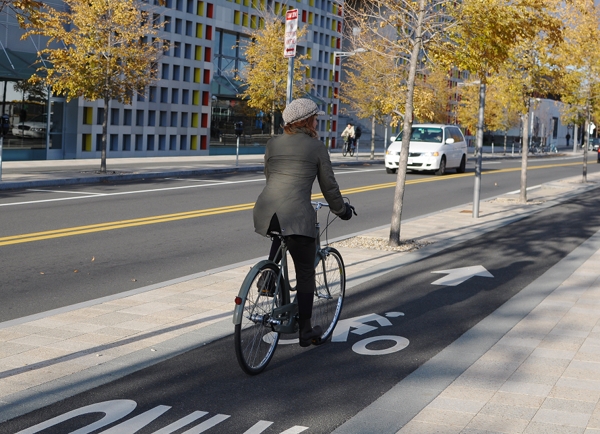 When a bicycle is this easy, comfortable and undemanding, you end up riding it all the time... which, ironically, ushers in my next complaint: Where are the lights? And more importantly, where is the rack? I would love to ride the Bella Ciao regularly for transportation, but there is nowhere to attach my bag and all the other stuff I take along, which is frustrating. The design of the bicycle will accommodate the VO Constructeur rear rack, and when I have the money I might get one. But I think that a rack in the style you see on some of these bicycles would be more appropriate. Anybody know where I could source one?
When a bicycle is this easy, comfortable and undemanding, you end up riding it all the time... which, ironically, ushers in my next complaint: Where are the lights? And more importantly, where is the rack? I would love to ride the Bella Ciao regularly for transportation, but there is nowhere to attach my bag and all the other stuff I take along, which is frustrating. The design of the bicycle will accommodate the VO Constructeur rear rack, and when I have the money I might get one. But I think that a rack in the style you see on some of these bicycles would be more appropriate. Anybody know where I could source one?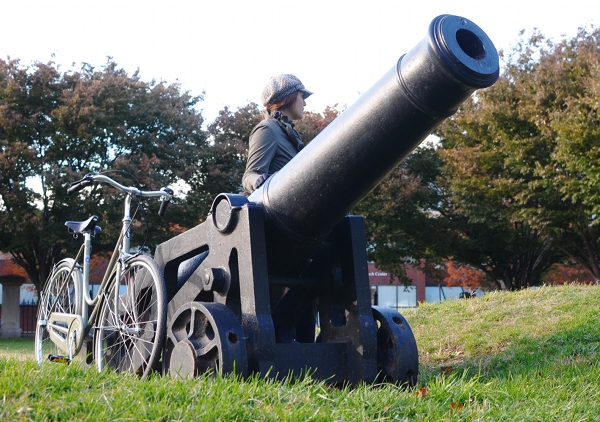 The Bella Ciao"Corvo Citta Donna" might just be the closest I have tried to an "all around, normal" bike out there today among classic lugged bicycles. And that was rather unexpected, given the quirkiness of the manufacturer's self-presentation. Free-association collages, stories of resistance against fascism - it is enough to raise the eyebrows of some and to make others wonder whether Bella Ciao is in reality a contemporary art project rather than a real bicycle company. Well, I suppose there is no reason it can't be both...
The Bella Ciao"Corvo Citta Donna" might just be the closest I have tried to an "all around, normal" bike out there today among classic lugged bicycles. And that was rather unexpected, given the quirkiness of the manufacturer's self-presentation. Free-association collages, stories of resistance against fascism - it is enough to raise the eyebrows of some and to make others wonder whether Bella Ciao is in reality a contemporary art project rather than a real bicycle company. Well, I suppose there is no reason it can't be both...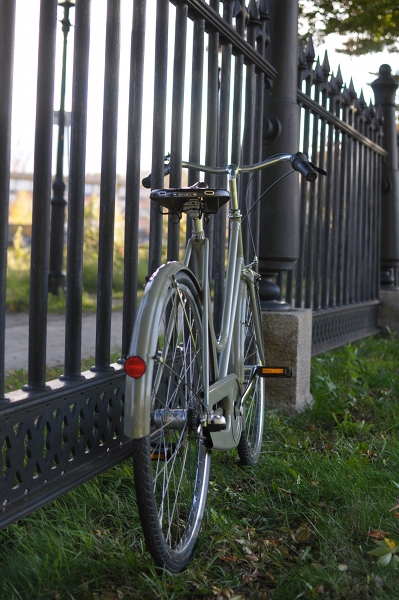 Though currently only sold in the EU, Bella Ciao is considering North American distributors and the bicycles may be available for sale in the US sometime in . The Corvo Citta Donna would certainlybe welcomed by women looking for more options in classic city bicycles.
Though currently only sold in the EU, Bella Ciao is considering North American distributors and the bicycles may be available for sale in the US sometime in . The Corvo Citta Donna would certainlybe welcomed by women looking for more options in classic city bicycles.


